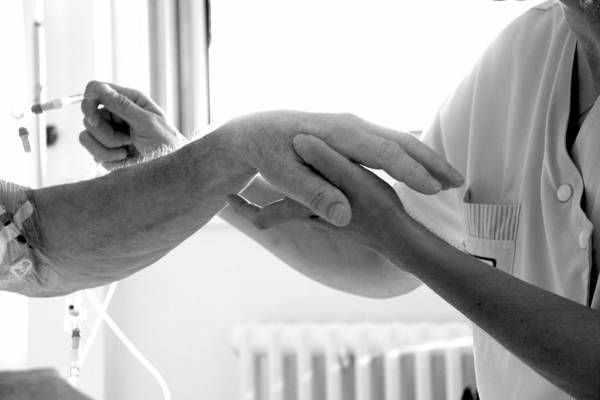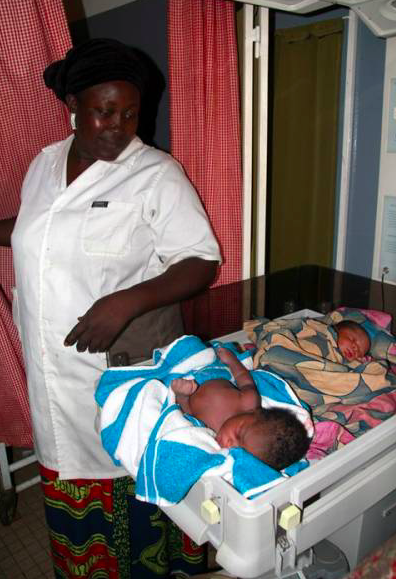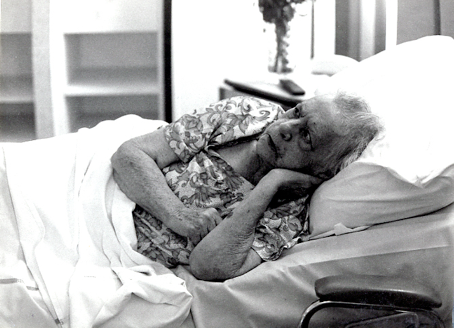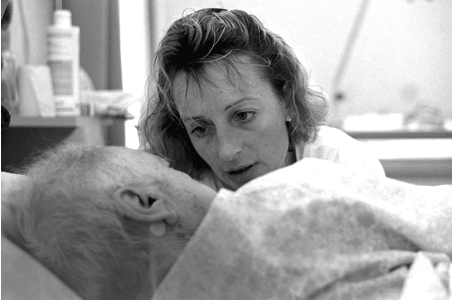I have a qualification in modern literature and I am a self-taught photographer. In the beginning, I took pictures on the street (street photography). Then, I immersed myself in the world of the hospital because I wanted to “test my ability to adapt” – to see if I could challenge myself by confronting painful topics affecting the vulnerability of the human. I asked myself – was I emotionally and intellectually able to turn a photographic eye on that which is most intimate in others? This became my starting point.
University Hospital was the first to accept me into their neonatal unit and this experience affected me deeply. The hospital is indeed a fantastic human laboratory that allowed me to grow professionally by confronting me with the photographic requirements of immersion report. Through these photographic experiments in neonatology, hematology and palliative care that formed my photographic eye, I could approach other subjects with great sensitivity. I honestly think that I could not photograph in the same way if I did not have my eye initially trained at the hospital. Indeed, these photos “live inside me” and I often think of caregivers and patients that I photographed. They are part of me.
I did not choose neonatology, instead neonatology chose me as it was the only unit that would allow my presence.
I thought it was good to start with birth, the beginning of all human existence. Through this work, I wanted to highlight the human skills of caregivers, their ability to provide comforting gestures, empathy for those children born prematurely. I wanted to show that the technical aspect, which is certainly essential to the survival of these children, is not the only predominant need and that human touch, even if it seems more subdued, is still an essential part of care. 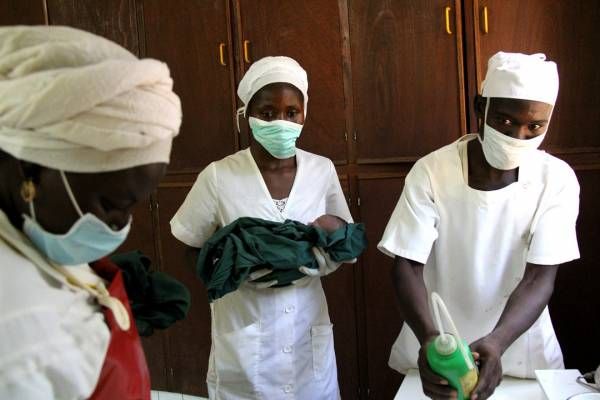
My approach was identical in the hematology department. It can be said that these more “sensitive units ” need “professional gratitude” or reverence among the caregivers.
At 23-years-old, I lost two of my best friends in a tragic accident. I was able to painfully measure that our supposedly civilized society denies death and the mourning that follows. In France, there are now psychiatrists who specialize in bereavement care, as if it were a neurosis to overcome. At this pivotal moment in my life when it was necessary that I accept the unacceptable and I also recognized the awkwardness which seemed to paralyze my friends from mourning.
But death is inevitable and we must find ways to face it. From where do our fears come from? How can we express our grief and accept the death of others? How do we prepare ourselves for death? All these existential questions are ignored as we are pressured to exist now. As society denies death by hiding it behind the sterile walls of the hospital, I made the therapeutic and artistic choice to actively immerse myself in the world of the hospital.
I wanted to demonstrate the richness and quality of a life ending, through the care of medical professionals and volunteers.
I believe that the concern for others in the palliative care unit is the essence of our humanity. It is in this moment of vulnerability, in dying, that we will all experience – when we long for a look, a gesture that denotes attention and respect, and us with the feeling of still being a human being.
 Through photography I wanted to focus on the two topics of neonatology (birth) and end of life (death) – to show that death is part of life and it is also as natural as birth. I also wanted to highlight the same gestures of nurturing, comforting and consolation in these two units.
Through photography I wanted to focus on the two topics of neonatology (birth) and end of life (death) – to show that death is part of life and it is also as natural as birth. I also wanted to highlight the same gestures of nurturing, comforting and consolation in these two units.
No gallery has agreed to show such a project. My photos are condemned to be seen in the corridors of hospitals, compartmentalized in this institution, which is currently the only response of a society that sees death as a failure.
Personally, the reactions aroused by my chosen subjects have always been guilt-inducing. Some saw this choice as an abandonment of the artistic dimension of my work or they insinuate morbidity or even voyeurism. My only creed and my personal conviction was to answer them. “I am a Man and nothing that is human is foreign to me.” (citation of Térence) Alas, death and end of life are still a very taboo subjects in France.
To integrate or at least come to be accepted in a hospital is always my first challenge – my eternal rock of Sisyphus. The first time I entered a chamber of the palliative care unit, it was in Lily’s room – she was suffering from generalized cancer. As I was barely through the door, the nearby church rang the death knell and she asked me, without giving me the time to say hello, if the bell is a death knell or wedding bells. The vivacity of her question surprised me and I could only answer, “A funeral.” Her reply was straightforward – “I’m afraid…” and that was the beginning of a beautiful relationship between photographer and subject. She tested me and I had won her trust by not disguising her reality. For Lily, I was able to truly hear her and not overshadow her fears with my own.
This is another picture of Lily being comforted by a caregiver. In the last days of my story, Lily was accustomed to awaken in an alarmed state several times a day as she was afraid to fall asleep.
I have wonderful memories of the palliative care staff. This is a great living experience – everything is life and given over to life: laughter, tears, anger, grief, joy, complicity. 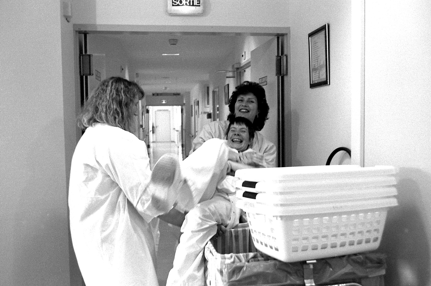
The hierarchy of hospital positions are meaningless here. All caregivers, including those responsible for the cleaning are invited to the meetings and all the uniforms are identical.
Six months after my father’s death , I went back to work in a hematology department. Here, I focused on the daily life of caregivers.
In these two photographs, the central subject is the patient. The memory of my father and the last moments I spent with him will always interfere in these two pictures. He also had moments of silence, solitude too, even though he was surrounded by relatives or caregivers.
The bed, the sheets are dramatized as funeral rites.
Through my photographic work and the wider dissemination of it, I sincerely hope to help our societies to put aside their own fear of mortality and begin to look at life from a thorough understanding of death; inviting us all to participate fully in the great adventure of life, without apprehension.
Sylvie Legoupi’s work can be found on her website.

